Annotated Bibliography on Social Media's Impact in the Workplace
VerifiedAdded on 2022/08/29
|9
|2463
|59
Annotated Bibliography
AI Summary
This annotated bibliography examines the multifaceted role of social media in the workplace, drawing on a range of academic sources. The bibliography explores various aspects, including how social media defines, develops, and divines; corporate social media usage; how scientists and other employees use social media for communication and collaboration; the impact of social media on productivity, team communication, and workplace learning; and the implications of social media in workplace conflict and labor movements. The sources analyzed include journal articles that provide insights into the advantages and disadvantages of social media, organizational policies, and the challenges and constraints associated with its use. Overall, the annotated bibliography offers a comprehensive overview of the evolving relationship between social media and the modern workplace, highlighting both the opportunities and the potential pitfalls of its integration into business practices.
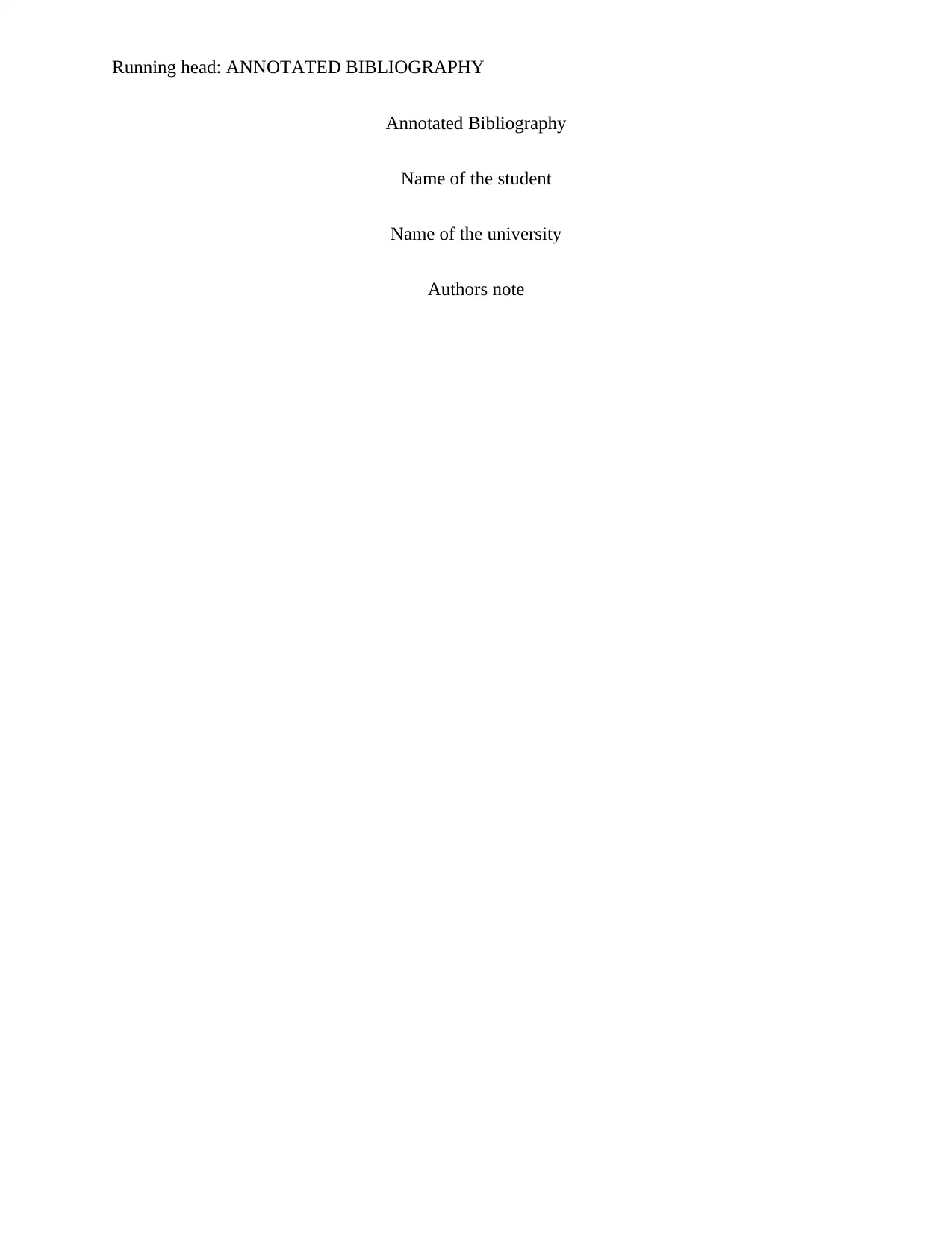
Running head: ANNOTATED BIBLIOGRAPHY
Annotated Bibliography
Name of the student
Name of the university
Authors note
Annotated Bibliography
Name of the student
Name of the university
Authors note
Paraphrase This Document
Need a fresh take? Get an instant paraphrase of this document with our AI Paraphraser
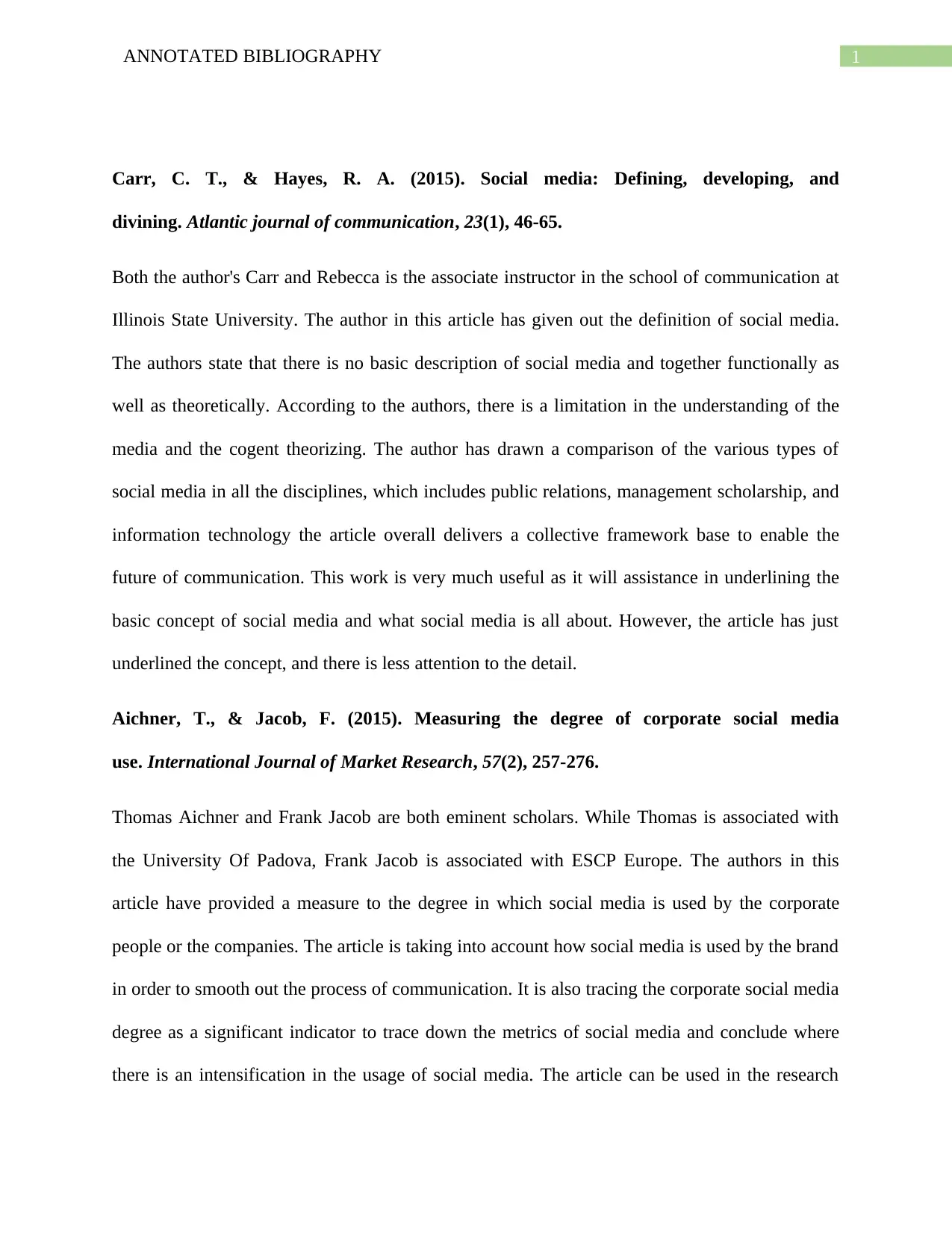
1ANNOTATED BIBLIOGRAPHY
Carr, C. T., & Hayes, R. A. (2015). Social media: Defining, developing, and
divining. Atlantic journal of communication, 23(1), 46-65.
Both the author's Carr and Rebecca is the associate instructor in the school of communication at
Illinois State University. The author in this article has given out the definition of social media.
The authors state that there is no basic description of social media and together functionally as
well as theoretically. According to the authors, there is a limitation in the understanding of the
media and the cogent theorizing. The author has drawn a comparison of the various types of
social media in all the disciplines, which includes public relations, management scholarship, and
information technology the article overall delivers a collective framework base to enable the
future of communication. This work is very much useful as it will assistance in underlining the
basic concept of social media and what social media is all about. However, the article has just
underlined the concept, and there is less attention to the detail.
Aichner, T., & Jacob, F. (2015). Measuring the degree of corporate social media
use. International Journal of Market Research, 57(2), 257-276.
Thomas Aichner and Frank Jacob are both eminent scholars. While Thomas is associated with
the University Of Padova, Frank Jacob is associated with ESCP Europe. The authors in this
article have provided a measure to the degree in which social media is used by the corporate
people or the companies. The article is taking into account how social media is used by the brand
in order to smooth out the process of communication. It is also tracing the corporate social media
degree as a significant indicator to trace down the metrics of social media and conclude where
there is an intensification in the usage of social media. The article can be used in the research
Carr, C. T., & Hayes, R. A. (2015). Social media: Defining, developing, and
divining. Atlantic journal of communication, 23(1), 46-65.
Both the author's Carr and Rebecca is the associate instructor in the school of communication at
Illinois State University. The author in this article has given out the definition of social media.
The authors state that there is no basic description of social media and together functionally as
well as theoretically. According to the authors, there is a limitation in the understanding of the
media and the cogent theorizing. The author has drawn a comparison of the various types of
social media in all the disciplines, which includes public relations, management scholarship, and
information technology the article overall delivers a collective framework base to enable the
future of communication. This work is very much useful as it will assistance in underlining the
basic concept of social media and what social media is all about. However, the article has just
underlined the concept, and there is less attention to the detail.
Aichner, T., & Jacob, F. (2015). Measuring the degree of corporate social media
use. International Journal of Market Research, 57(2), 257-276.
Thomas Aichner and Frank Jacob are both eminent scholars. While Thomas is associated with
the University Of Padova, Frank Jacob is associated with ESCP Europe. The authors in this
article have provided a measure to the degree in which social media is used by the corporate
people or the companies. The article is taking into account how social media is used by the brand
in order to smooth out the process of communication. It is also tracing the corporate social media
degree as a significant indicator to trace down the metrics of social media and conclude where
there is an intensification in the usage of social media. The article can be used in the research
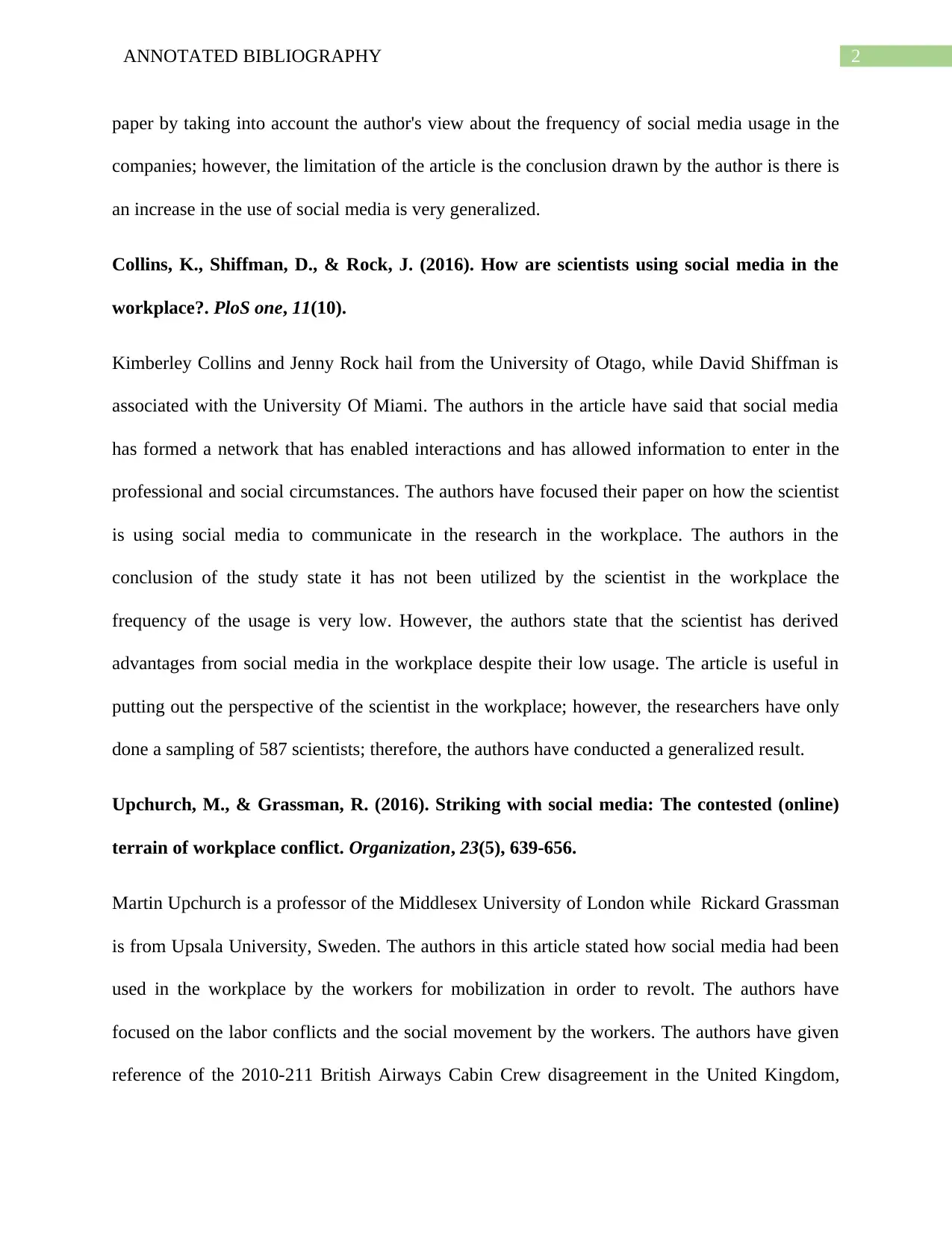
2ANNOTATED BIBLIOGRAPHY
paper by taking into account the author's view about the frequency of social media usage in the
companies; however, the limitation of the article is the conclusion drawn by the author is there is
an increase in the use of social media is very generalized.
Collins, K., Shiffman, D., & Rock, J. (2016). How are scientists using social media in the
workplace?. PloS one, 11(10).
Kimberley Collins and Jenny Rock hail from the University of Otago, while David Shiffman is
associated with the University Of Miami. The authors in the article have said that social media
has formed a network that has enabled interactions and has allowed information to enter in the
professional and social circumstances. The authors have focused their paper on how the scientist
is using social media to communicate in the research in the workplace. The authors in the
conclusion of the study state it has not been utilized by the scientist in the workplace the
frequency of the usage is very low. However, the authors state that the scientist has derived
advantages from social media in the workplace despite their low usage. The article is useful in
putting out the perspective of the scientist in the workplace; however, the researchers have only
done a sampling of 587 scientists; therefore, the authors have conducted a generalized result.
Upchurch, M., & Grassman, R. (2016). Striking with social media: The contested (online)
terrain of workplace conflict. Organization, 23(5), 639-656.
Martin Upchurch is a professor of the Middlesex University of London while Rickard Grassman
is from Upsala University, Sweden. The authors in this article stated how social media had been
used in the workplace by the workers for mobilization in order to revolt. The authors have
focused on the labor conflicts and the social movement by the workers. The authors have given
reference of the 2010-211 British Airways Cabin Crew disagreement in the United Kingdom,
paper by taking into account the author's view about the frequency of social media usage in the
companies; however, the limitation of the article is the conclusion drawn by the author is there is
an increase in the use of social media is very generalized.
Collins, K., Shiffman, D., & Rock, J. (2016). How are scientists using social media in the
workplace?. PloS one, 11(10).
Kimberley Collins and Jenny Rock hail from the University of Otago, while David Shiffman is
associated with the University Of Miami. The authors in the article have said that social media
has formed a network that has enabled interactions and has allowed information to enter in the
professional and social circumstances. The authors have focused their paper on how the scientist
is using social media to communicate in the research in the workplace. The authors in the
conclusion of the study state it has not been utilized by the scientist in the workplace the
frequency of the usage is very low. However, the authors state that the scientist has derived
advantages from social media in the workplace despite their low usage. The article is useful in
putting out the perspective of the scientist in the workplace; however, the researchers have only
done a sampling of 587 scientists; therefore, the authors have conducted a generalized result.
Upchurch, M., & Grassman, R. (2016). Striking with social media: The contested (online)
terrain of workplace conflict. Organization, 23(5), 639-656.
Martin Upchurch is a professor of the Middlesex University of London while Rickard Grassman
is from Upsala University, Sweden. The authors in this article stated how social media had been
used in the workplace by the workers for mobilization in order to revolt. The authors have
focused on the labor conflicts and the social movement by the workers. The authors have given
reference of the 2010-211 British Airways Cabin Crew disagreement in the United Kingdom,
⊘ This is a preview!⊘
Do you want full access?
Subscribe today to unlock all pages.

Trusted by 1+ million students worldwide
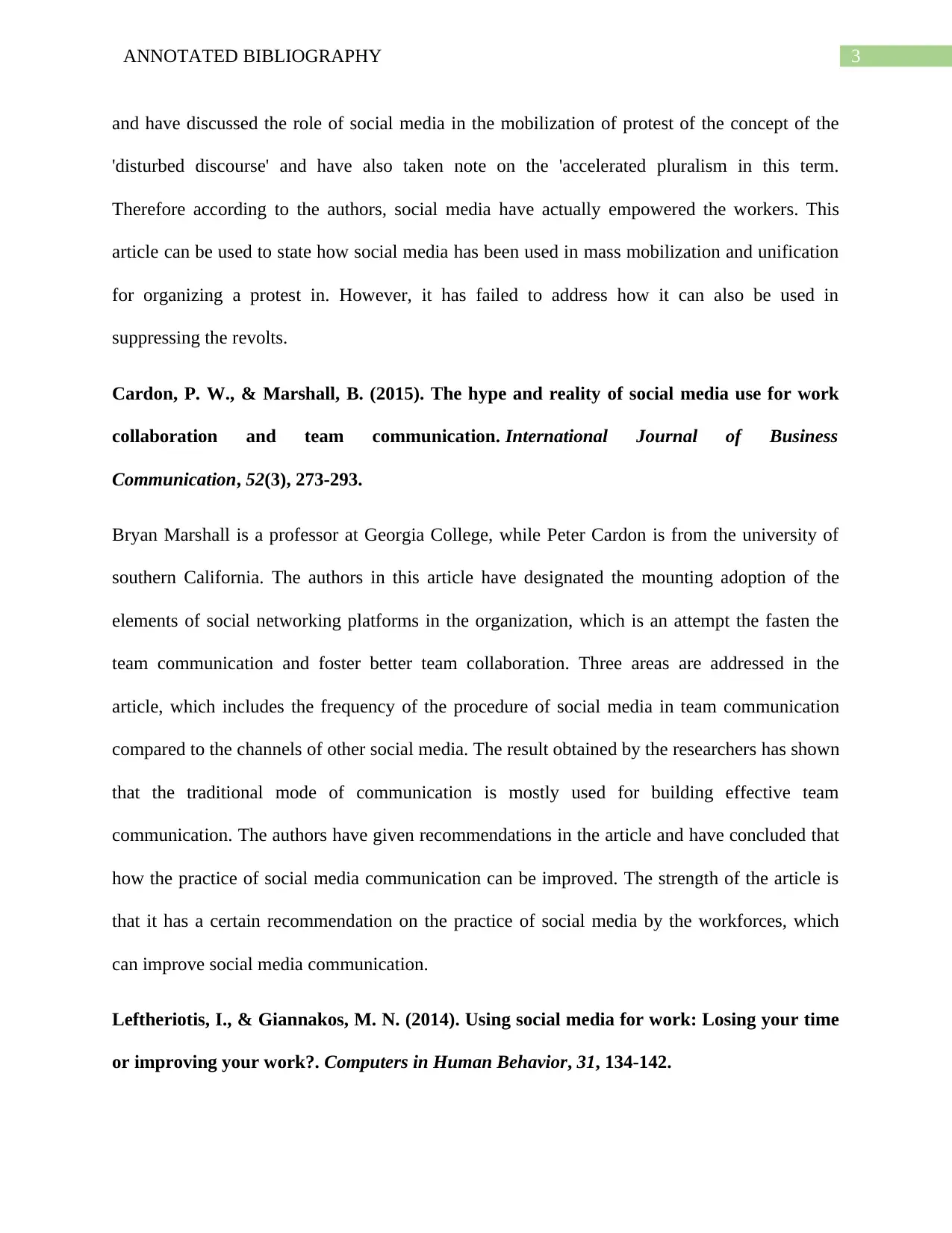
3ANNOTATED BIBLIOGRAPHY
and have discussed the role of social media in the mobilization of protest of the concept of the
'disturbed discourse' and have also taken note on the 'accelerated pluralism in this term.
Therefore according to the authors, social media have actually empowered the workers. This
article can be used to state how social media has been used in mass mobilization and unification
for organizing a protest in. However, it has failed to address how it can also be used in
suppressing the revolts.
Cardon, P. W., & Marshall, B. (2015). The hype and reality of social media use for work
collaboration and team communication. International Journal of Business
Communication, 52(3), 273-293.
Bryan Marshall is a professor at Georgia College, while Peter Cardon is from the university of
southern California. The authors in this article have designated the mounting adoption of the
elements of social networking platforms in the organization, which is an attempt the fasten the
team communication and foster better team collaboration. Three areas are addressed in the
article, which includes the frequency of the procedure of social media in team communication
compared to the channels of other social media. The result obtained by the researchers has shown
that the traditional mode of communication is mostly used for building effective team
communication. The authors have given recommendations in the article and have concluded that
how the practice of social media communication can be improved. The strength of the article is
that it has a certain recommendation on the practice of social media by the workforces, which
can improve social media communication.
Leftheriotis, I., & Giannakos, M. N. (2014). Using social media for work: Losing your time
or improving your work?. Computers in Human Behavior, 31, 134-142.
and have discussed the role of social media in the mobilization of protest of the concept of the
'disturbed discourse' and have also taken note on the 'accelerated pluralism in this term.
Therefore according to the authors, social media have actually empowered the workers. This
article can be used to state how social media has been used in mass mobilization and unification
for organizing a protest in. However, it has failed to address how it can also be used in
suppressing the revolts.
Cardon, P. W., & Marshall, B. (2015). The hype and reality of social media use for work
collaboration and team communication. International Journal of Business
Communication, 52(3), 273-293.
Bryan Marshall is a professor at Georgia College, while Peter Cardon is from the university of
southern California. The authors in this article have designated the mounting adoption of the
elements of social networking platforms in the organization, which is an attempt the fasten the
team communication and foster better team collaboration. Three areas are addressed in the
article, which includes the frequency of the procedure of social media in team communication
compared to the channels of other social media. The result obtained by the researchers has shown
that the traditional mode of communication is mostly used for building effective team
communication. The authors have given recommendations in the article and have concluded that
how the practice of social media communication can be improved. The strength of the article is
that it has a certain recommendation on the practice of social media by the workforces, which
can improve social media communication.
Leftheriotis, I., & Giannakos, M. N. (2014). Using social media for work: Losing your time
or improving your work?. Computers in Human Behavior, 31, 134-142.
Paraphrase This Document
Need a fresh take? Get an instant paraphrase of this document with our AI Paraphraser
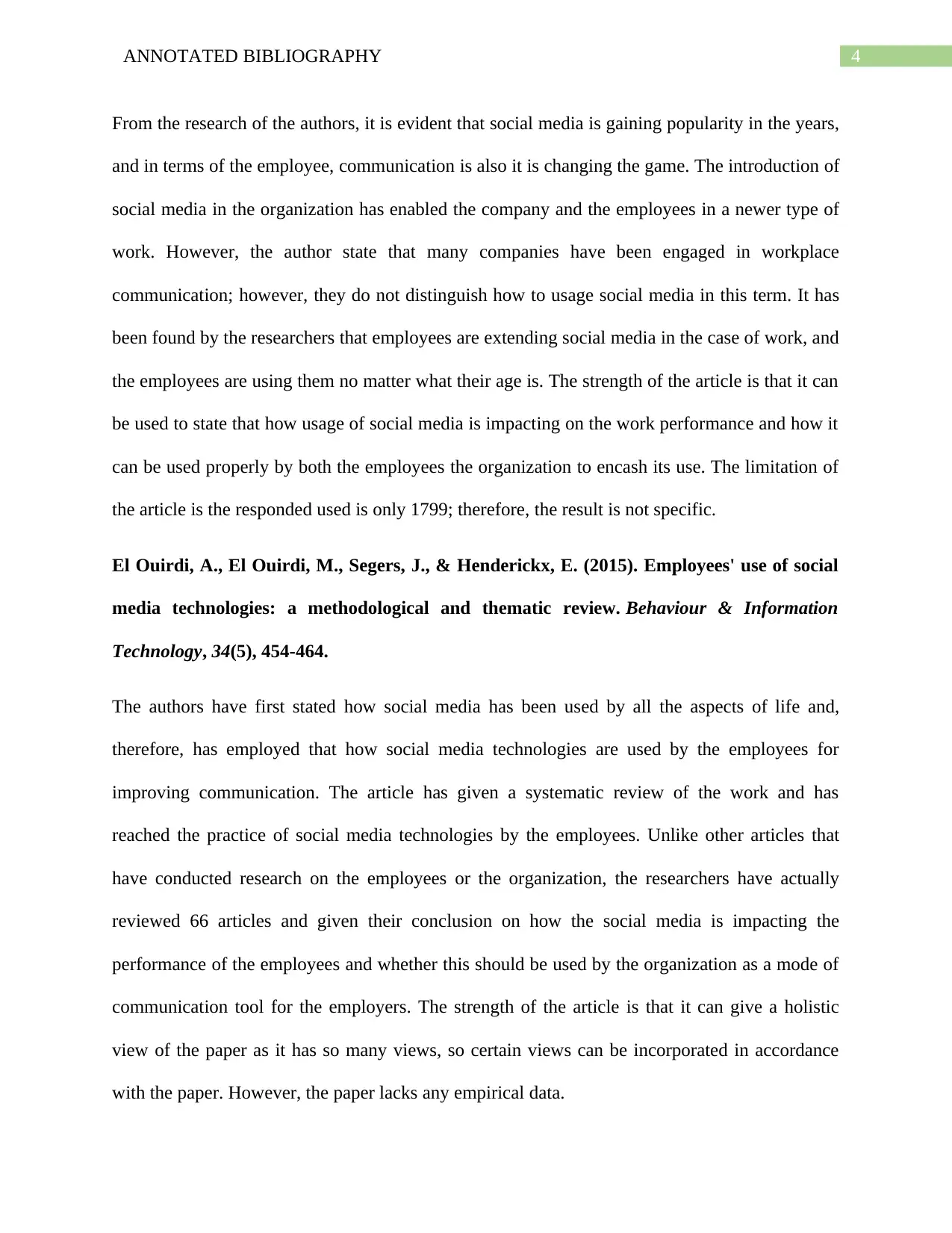
4ANNOTATED BIBLIOGRAPHY
From the research of the authors, it is evident that social media is gaining popularity in the years,
and in terms of the employee, communication is also it is changing the game. The introduction of
social media in the organization has enabled the company and the employees in a newer type of
work. However, the author state that many companies have been engaged in workplace
communication; however, they do not distinguish how to usage social media in this term. It has
been found by the researchers that employees are extending social media in the case of work, and
the employees are using them no matter what their age is. The strength of the article is that it can
be used to state that how usage of social media is impacting on the work performance and how it
can be used properly by both the employees the organization to encash its use. The limitation of
the article is the responded used is only 1799; therefore, the result is not specific.
El Ouirdi, A., El Ouirdi, M., Segers, J., & Henderickx, E. (2015). Employees' use of social
media technologies: a methodological and thematic review. Behaviour & Information
Technology, 34(5), 454-464.
The authors have first stated how social media has been used by all the aspects of life and,
therefore, has employed that how social media technologies are used by the employees for
improving communication. The article has given a systematic review of the work and has
reached the practice of social media technologies by the employees. Unlike other articles that
have conducted research on the employees or the organization, the researchers have actually
reviewed 66 articles and given their conclusion on how the social media is impacting the
performance of the employees and whether this should be used by the organization as a mode of
communication tool for the employers. The strength of the article is that it can give a holistic
view of the paper as it has so many views, so certain views can be incorporated in accordance
with the paper. However, the paper lacks any empirical data.
From the research of the authors, it is evident that social media is gaining popularity in the years,
and in terms of the employee, communication is also it is changing the game. The introduction of
social media in the organization has enabled the company and the employees in a newer type of
work. However, the author state that many companies have been engaged in workplace
communication; however, they do not distinguish how to usage social media in this term. It has
been found by the researchers that employees are extending social media in the case of work, and
the employees are using them no matter what their age is. The strength of the article is that it can
be used to state that how usage of social media is impacting on the work performance and how it
can be used properly by both the employees the organization to encash its use. The limitation of
the article is the responded used is only 1799; therefore, the result is not specific.
El Ouirdi, A., El Ouirdi, M., Segers, J., & Henderickx, E. (2015). Employees' use of social
media technologies: a methodological and thematic review. Behaviour & Information
Technology, 34(5), 454-464.
The authors have first stated how social media has been used by all the aspects of life and,
therefore, has employed that how social media technologies are used by the employees for
improving communication. The article has given a systematic review of the work and has
reached the practice of social media technologies by the employees. Unlike other articles that
have conducted research on the employees or the organization, the researchers have actually
reviewed 66 articles and given their conclusion on how the social media is impacting the
performance of the employees and whether this should be used by the organization as a mode of
communication tool for the employers. The strength of the article is that it can give a holistic
view of the paper as it has so many views, so certain views can be incorporated in accordance
with the paper. However, the paper lacks any empirical data.
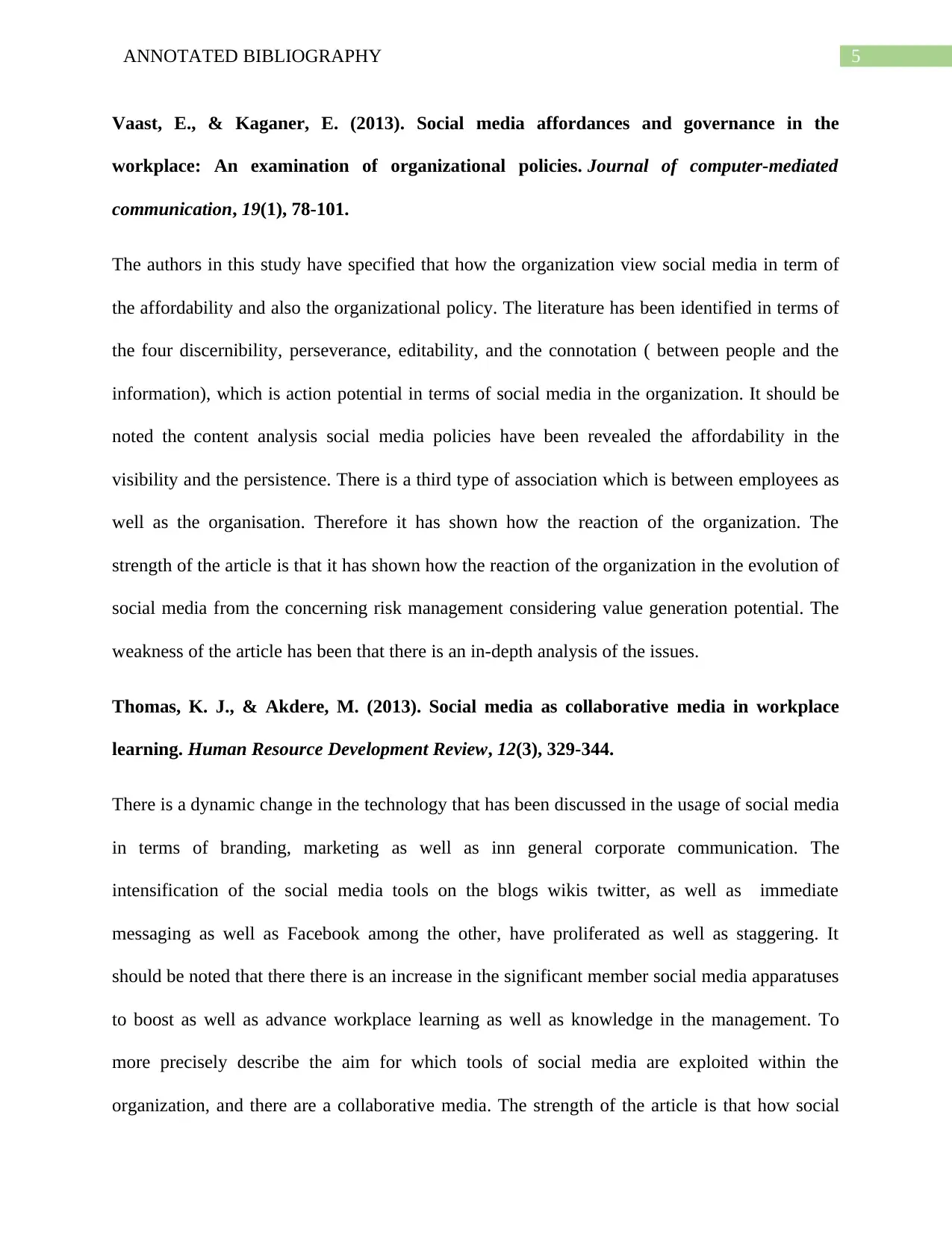
5ANNOTATED BIBLIOGRAPHY
Vaast, E., & Kaganer, E. (2013). Social media affordances and governance in the
workplace: An examination of organizational policies. Journal of computer-mediated
communication, 19(1), 78-101.
The authors in this study have specified that how the organization view social media in term of
the affordability and also the organizational policy. The literature has been identified in terms of
the four discernibility, perseverance, editability, and the connotation ( between people and the
information), which is action potential in terms of social media in the organization. It should be
noted the content analysis social media policies have been revealed the affordability in the
visibility and the persistence. There is a third type of association which is between employees as
well as the organisation. Therefore it has shown how the reaction of the organization. The
strength of the article is that it has shown how the reaction of the organization in the evolution of
social media from the concerning risk management considering value generation potential. The
weakness of the article has been that there is an in-depth analysis of the issues.
Thomas, K. J., & Akdere, M. (2013). Social media as collaborative media in workplace
learning. Human Resource Development Review, 12(3), 329-344.
There is a dynamic change in the technology that has been discussed in the usage of social media
in terms of branding, marketing as well as inn general corporate communication. The
intensification of the social media tools on the blogs wikis twitter, as well as immediate
messaging as well as Facebook among the other, have proliferated as well as staggering. It
should be noted that there there is an increase in the significant member social media apparatuses
to boost as well as advance workplace learning as well as knowledge in the management. To
more precisely describe the aim for which tools of social media are exploited within the
organization, and there are a collaborative media. The strength of the article is that how social
Vaast, E., & Kaganer, E. (2013). Social media affordances and governance in the
workplace: An examination of organizational policies. Journal of computer-mediated
communication, 19(1), 78-101.
The authors in this study have specified that how the organization view social media in term of
the affordability and also the organizational policy. The literature has been identified in terms of
the four discernibility, perseverance, editability, and the connotation ( between people and the
information), which is action potential in terms of social media in the organization. It should be
noted the content analysis social media policies have been revealed the affordability in the
visibility and the persistence. There is a third type of association which is between employees as
well as the organisation. Therefore it has shown how the reaction of the organization. The
strength of the article is that it has shown how the reaction of the organization in the evolution of
social media from the concerning risk management considering value generation potential. The
weakness of the article has been that there is an in-depth analysis of the issues.
Thomas, K. J., & Akdere, M. (2013). Social media as collaborative media in workplace
learning. Human Resource Development Review, 12(3), 329-344.
There is a dynamic change in the technology that has been discussed in the usage of social media
in terms of branding, marketing as well as inn general corporate communication. The
intensification of the social media tools on the blogs wikis twitter, as well as immediate
messaging as well as Facebook among the other, have proliferated as well as staggering. It
should be noted that there there is an increase in the significant member social media apparatuses
to boost as well as advance workplace learning as well as knowledge in the management. To
more precisely describe the aim for which tools of social media are exploited within the
organization, and there are a collaborative media. The strength of the article is that how social
⊘ This is a preview!⊘
Do you want full access?
Subscribe today to unlock all pages.

Trusted by 1+ million students worldwide
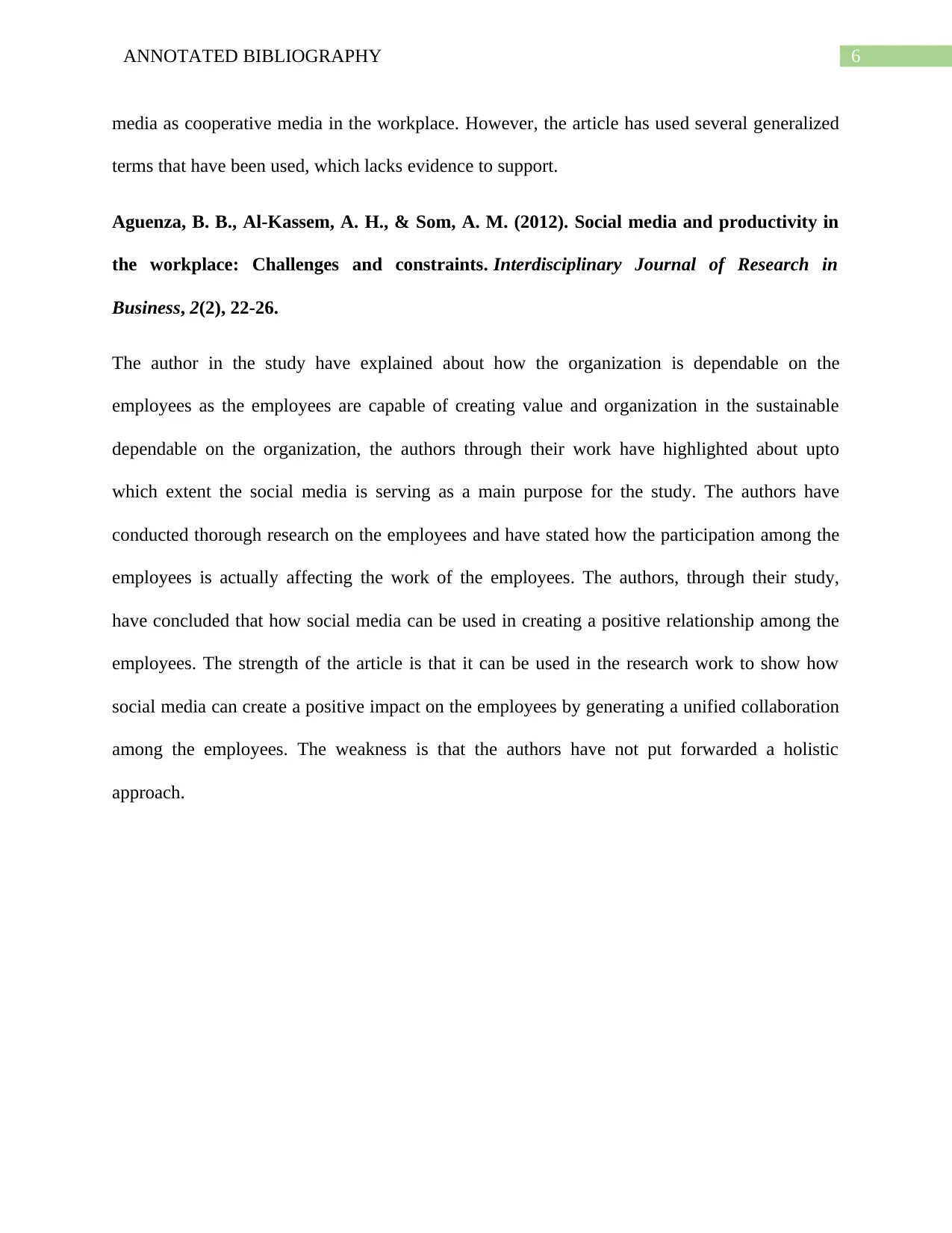
6ANNOTATED BIBLIOGRAPHY
media as cooperative media in the workplace. However, the article has used several generalized
terms that have been used, which lacks evidence to support.
Aguenza, B. B., Al-Kassem, A. H., & Som, A. M. (2012). Social media and productivity in
the workplace: Challenges and constraints. Interdisciplinary Journal of Research in
Business, 2(2), 22-26.
The author in the study have explained about how the organization is dependable on the
employees as the employees are capable of creating value and organization in the sustainable
dependable on the organization, the authors through their work have highlighted about upto
which extent the social media is serving as a main purpose for the study. The authors have
conducted thorough research on the employees and have stated how the participation among the
employees is actually affecting the work of the employees. The authors, through their study,
have concluded that how social media can be used in creating a positive relationship among the
employees. The strength of the article is that it can be used in the research work to show how
social media can create a positive impact on the employees by generating a unified collaboration
among the employees. The weakness is that the authors have not put forwarded a holistic
approach.
media as cooperative media in the workplace. However, the article has used several generalized
terms that have been used, which lacks evidence to support.
Aguenza, B. B., Al-Kassem, A. H., & Som, A. M. (2012). Social media and productivity in
the workplace: Challenges and constraints. Interdisciplinary Journal of Research in
Business, 2(2), 22-26.
The author in the study have explained about how the organization is dependable on the
employees as the employees are capable of creating value and organization in the sustainable
dependable on the organization, the authors through their work have highlighted about upto
which extent the social media is serving as a main purpose for the study. The authors have
conducted thorough research on the employees and have stated how the participation among the
employees is actually affecting the work of the employees. The authors, through their study,
have concluded that how social media can be used in creating a positive relationship among the
employees. The strength of the article is that it can be used in the research work to show how
social media can create a positive impact on the employees by generating a unified collaboration
among the employees. The weakness is that the authors have not put forwarded a holistic
approach.
Paraphrase This Document
Need a fresh take? Get an instant paraphrase of this document with our AI Paraphraser
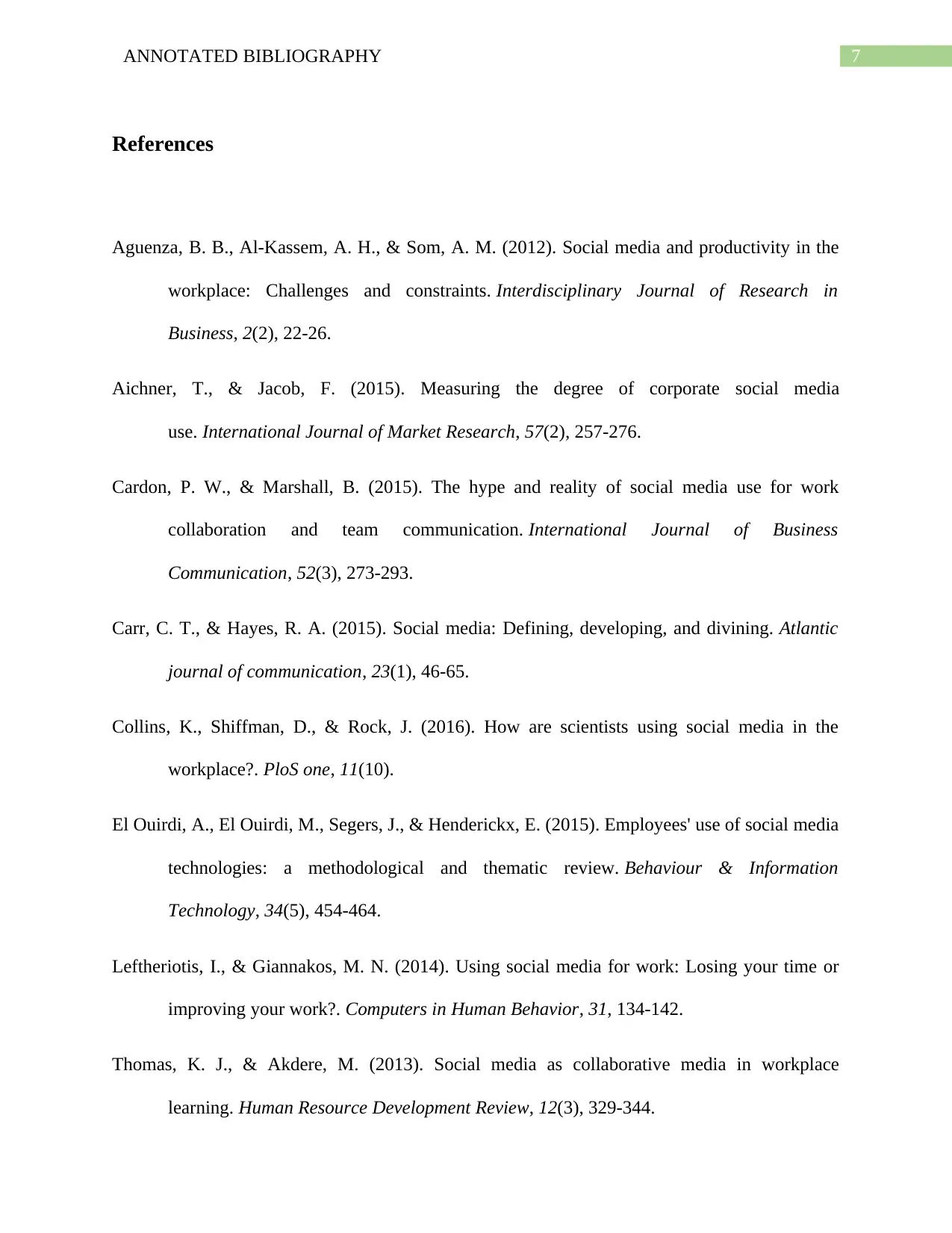
7ANNOTATED BIBLIOGRAPHY
References
Aguenza, B. B., Al-Kassem, A. H., & Som, A. M. (2012). Social media and productivity in the
workplace: Challenges and constraints. Interdisciplinary Journal of Research in
Business, 2(2), 22-26.
Aichner, T., & Jacob, F. (2015). Measuring the degree of corporate social media
use. International Journal of Market Research, 57(2), 257-276.
Cardon, P. W., & Marshall, B. (2015). The hype and reality of social media use for work
collaboration and team communication. International Journal of Business
Communication, 52(3), 273-293.
Carr, C. T., & Hayes, R. A. (2015). Social media: Defining, developing, and divining. Atlantic
journal of communication, 23(1), 46-65.
Collins, K., Shiffman, D., & Rock, J. (2016). How are scientists using social media in the
workplace?. PloS one, 11(10).
El Ouirdi, A., El Ouirdi, M., Segers, J., & Henderickx, E. (2015). Employees' use of social media
technologies: a methodological and thematic review. Behaviour & Information
Technology, 34(5), 454-464.
Leftheriotis, I., & Giannakos, M. N. (2014). Using social media for work: Losing your time or
improving your work?. Computers in Human Behavior, 31, 134-142.
Thomas, K. J., & Akdere, M. (2013). Social media as collaborative media in workplace
learning. Human Resource Development Review, 12(3), 329-344.
References
Aguenza, B. B., Al-Kassem, A. H., & Som, A. M. (2012). Social media and productivity in the
workplace: Challenges and constraints. Interdisciplinary Journal of Research in
Business, 2(2), 22-26.
Aichner, T., & Jacob, F. (2015). Measuring the degree of corporate social media
use. International Journal of Market Research, 57(2), 257-276.
Cardon, P. W., & Marshall, B. (2015). The hype and reality of social media use for work
collaboration and team communication. International Journal of Business
Communication, 52(3), 273-293.
Carr, C. T., & Hayes, R. A. (2015). Social media: Defining, developing, and divining. Atlantic
journal of communication, 23(1), 46-65.
Collins, K., Shiffman, D., & Rock, J. (2016). How are scientists using social media in the
workplace?. PloS one, 11(10).
El Ouirdi, A., El Ouirdi, M., Segers, J., & Henderickx, E. (2015). Employees' use of social media
technologies: a methodological and thematic review. Behaviour & Information
Technology, 34(5), 454-464.
Leftheriotis, I., & Giannakos, M. N. (2014). Using social media for work: Losing your time or
improving your work?. Computers in Human Behavior, 31, 134-142.
Thomas, K. J., & Akdere, M. (2013). Social media as collaborative media in workplace
learning. Human Resource Development Review, 12(3), 329-344.
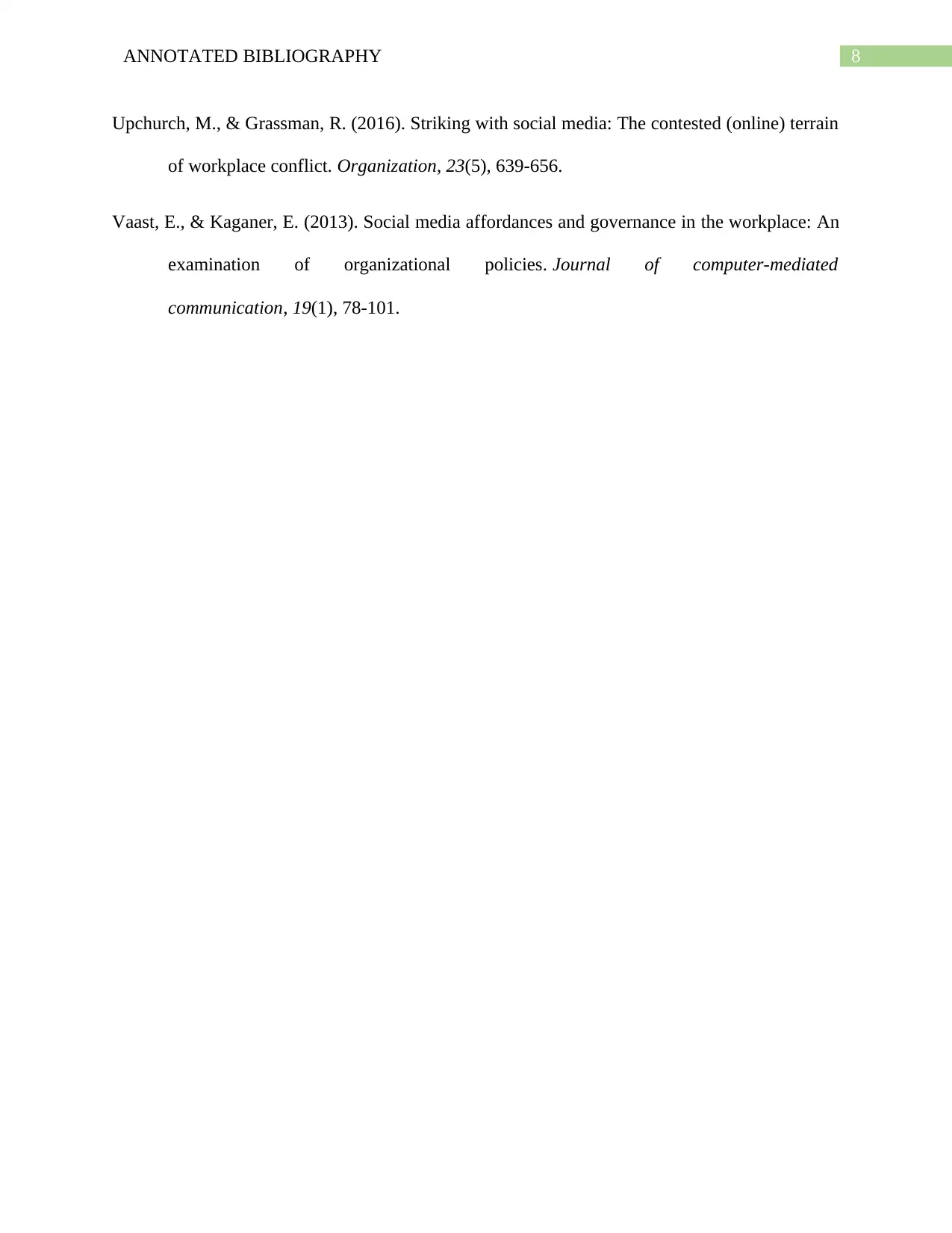
8ANNOTATED BIBLIOGRAPHY
Upchurch, M., & Grassman, R. (2016). Striking with social media: The contested (online) terrain
of workplace conflict. Organization, 23(5), 639-656.
Vaast, E., & Kaganer, E. (2013). Social media affordances and governance in the workplace: An
examination of organizational policies. Journal of computer-mediated
communication, 19(1), 78-101.
Upchurch, M., & Grassman, R. (2016). Striking with social media: The contested (online) terrain
of workplace conflict. Organization, 23(5), 639-656.
Vaast, E., & Kaganer, E. (2013). Social media affordances and governance in the workplace: An
examination of organizational policies. Journal of computer-mediated
communication, 19(1), 78-101.
⊘ This is a preview!⊘
Do you want full access?
Subscribe today to unlock all pages.

Trusted by 1+ million students worldwide
1 out of 9
Your All-in-One AI-Powered Toolkit for Academic Success.
+13062052269
info@desklib.com
Available 24*7 on WhatsApp / Email
![[object Object]](/_next/static/media/star-bottom.7253800d.svg)
Unlock your academic potential
Copyright © 2020–2025 A2Z Services. All Rights Reserved. Developed and managed by ZUCOL.
